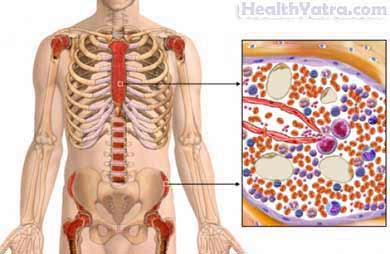Definition
Multiple myeloma is a rare cancer of the bone marrow. It results from the abnormal growth of plasma cells in the bone marrow. Plasma cells normally produce antibodies. As these abnormal or malignant plasma cells multiply, they produce large quantities of abnormal antibodies. These abnormal antibodies collect in the blood and urine. As the plasma cell tumor grows, it also destroys the bone around it. These events lead to bone pain, kidney damage, and a weak immune system.
Cancer occurs when cells in the body (in this case plasma cells) divide without control or order. Normally, cells divide in a regulated manner. If cells keep dividing uncontrollably, a mass of tissue forms, called a growth or tumor. The term cancer refers to malignant tumors, which can invade nearby tissue and spread to other parts of the body. A benign tumor does not invade or spread.

Causes
The cause of multiple myeloma is not known.
Risk Factors
Risk factors that increase your chance of getting multiple myeloma include:
- Age: 50 or older
- Race: black
Symptoms
Symptoms of early stage multiple myeloma include:
- Persistent bone pain, often severe. It is most common in the back but also in the limbs or ribs.
- Fatigue
When the disease progresses, symptoms may include:
- Fatigue
- Weakness
- Broken bones
- Repeat infections
- Nausea and vomiting
- Constipation
- Difficulty urinating
- Abnormal bleeding
- Headache
- Visual problems
- Confusion
Diagnosis
The doctor will ask about your symptoms and medical history. A physical exam will be done.
Your doctor may need pictures of your bones. This can be done with:
- X-rays
- Magnetic resonance imaging (MRI)
- Computed tomography scan (CT scan)
- Positron emission tomography/computed tomography scan (PET/CT scan)
Your doctor may order tests of your body fluids and tissues. This can be done with:
- Blood tests
- Urine tests
- Bone marrow aspiration or biopsy
Treatment
After cancer is found, staging tests are done to find out if the cancer has spread. Treatment is sometimes able to slow the progress of multiple myeloma. Complete remission is rare. Treatment is also important to control symptoms. Treatment depends on your symptoms and the stage of your cancer. Options include:
Chemotherapy
Chemotherapy is the use of drugs to kill cancer cells. Chemotherapy may be given in many forms including: pill, injection, and via a catheter. The drugs enter the bloodstream and travel through the body. The drugs kill mostly cancer cells. Some healthy cells may be killed in the process.
Chemotherapy drugs are used in combination and may also be given with other types of medicines, like immunomodulating agents.
Immunomodulating Agents
Immunomodulating agents work by changing the way the myeloma cells live. This makes it difficult for them to survive, reproduce, and produce proteins that cause symptoms. These medicines are often paired with a corticosteroid.
Corticosteroids
Corticosteroids may be combined with other medicines or given alone. Corticosteroids can also help to treat the symptoms of chemotherapy, like nausea and vomiting.
Proteasome Inhibitor
A proteasome inhibitor is also available to treat multiple myeloma. Proteasomes are a type of protein complex that breaks down proteins. It inhibits proteasomes, which causes more proteins to be in the cells. Because of these extra proteins, the cells eventually do not grow anymore.
Bisphosphonates
Bisphosphonates are given to slow the process of bone loss.
Biologic Therapies
Biologic therapies repair, encourage, or raise the body’s response to cancer by affecting the immune system. Interferon is one biologic agent used to treat multiple myeloma. Interferon may be used with chemotherapy to help prolong remission, slowing the speed at which myeloma cells grow.
Radiation Therapy
Radiation therapy is the use of radiation to kill cancer cells and shrink tumors. External beam radiation therapy may be given to relieve bone pain. It is not considered a cure.
Surgery
Surgery is done to remove a tumor that causes pain or other disabling symptoms when radiation therapy is not considered a good option. Surgery is not a cure.
Peripheral Stem Cell Transplant
Peripheral stem cell transplant involves giving immature, healthy blood cells to replace bone marrow cells that are damaged by cancer.
Plasmapheresis
Plasmapheresis is done to exchange plasma in the blood. Plasma is the liquid part of the blood that does not contain cells. After the plasma is removed, fresh plasma or a plasma substitute is added back to the blood. This treatment is done to remove the myeloma proteins from the blood.
Prevention
There are no guidelines to prevent multiple myeloma. The cause is not known.
